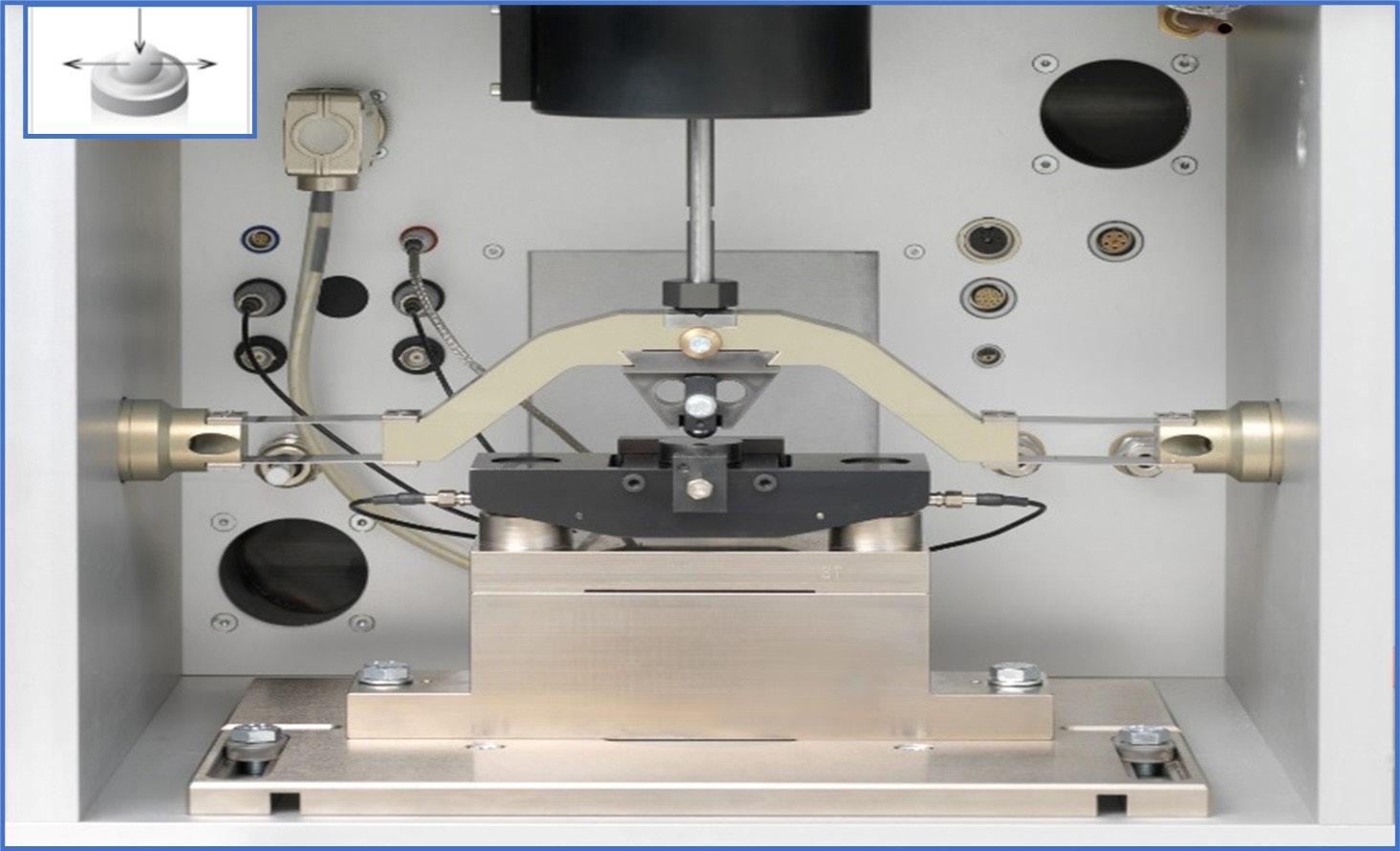
18 minute read
Tribological Performance of Greases Different Tribological Test Modes
Ameneh Schneider, Optimol Instruments Prüftechnik GmbH, Munich/Germany Mathias Woydt, Matrilub, MATRILUB Materials Ι Tribology Ι Lubrication, Berlin/Germany
Abstract:
Lubricating greases can be used in a wide range of applications and conditions, and they are gaining more importance for e-mobility. Lubricating greases and lubricating oils behave differently in tribo¬logical contacts. The complex tribological characteristics of greases have been discussed through the last decades; the effect of thickeners on tribological performance has been the core of many publications. The aim of this study is to investigate the influence of test parameters and modes on the tribological response of differently formulated greases. Challenges such as modeling the operating conditions in the field with the test environment are discussed. Special emphasis is placed on types of motion, velocity, and temperature as well as test geometry. In addition to the coefficient of friction, the associated wear volumes are taken into consideration.
1. Introduction
Greases are the most versatile and functionalized lubricants, and they can be used in a wide range of applications and conditions. There are various lubricating grease types with complex behavior depending on the type and amount of thickener, additives, and base oil viscosities. Lubricating greases and lubricating oils behave differently in tribological contacts. The complex tribology of greases has been discussed through the last decades. In particular, the effect of thickeners on the tribological performance has been emphasized [1,2,3]. It has also been concluded that the condition of full lubrication cannot be expected in highly stressed contacts, and the formation of the film differs depending on the type of thickener (e.g., with or without fibrous portions). J. Wang et al. [2] explained that the mean and minimal film thicknesses stabilize after hundreds of cycles, independent from the total speed. They also explained that film formation by greases in rolling and sliding contacts can be influenced by temperature and surface roughness of materials. K. Kanazawa et al. [3] suggested that for slowly running conditions, the grease behavior is influenced by the thickener, while for fast running conditions, the base oil is more critical than the thickener. By adding solids (e.g., graphite, Mo2S, or PTFE) to greases to improve the tribological properties, the rheological properties, especially the value of the shear stress, are influenced. The extent of this influence depends, again, on the type of grease thickener [4]. Patzer explained results from a tribological study using the translatory [translational] oscillation tribometer SRV® (Schwing (oscillation), Reib (friction), Verschleiß (wear)) and different standardized test methods to evaluate greases that meet application, economic, and ecological targets [5]. Furthermore, investigations of wear scars and comparisons of effective coefficients of friction (COFs) for different formulations can elucidate a deeper understanding of the tribological complexity of lubricating greases. Fathi-Najafi et al. [6] investigated the impact of high viscosity naphthenic base oil on different thickeners by using an SRV® tribometer [6]. Weber et al. discussed the importance of test parameters when using DIN 51834, part 2 and ASTM D7594 (fretting tests) to develop highperformance (HP) greases [7]. The future of grease development is going towards energy efficient greases. By optimizing the lubrication of the bearings, theoretical improvements of energy efficiency are predicted.
Besides the linear oscillating movement of a ball on a disk with an SRV®, a new adapter was recently developed to simulate rolling movement. This special procedure can differentiate between rolling friction and resulting wear of formulated greases [8,9].
2. Experimental work
High-quality greases very often show minimal differences regarding their lubricity but differ significantly in terms of wear protection. However, performance differences should be assessed to classify advantages or disadvantages of a grease formulation under given operating conditions. Modern tribometric test systems like the SRV® provide both types of information, suitable tools, and a portfolio of validated test methods to get a deeper understanding of tribological and lubricity behavior of greases. For decades, the SRV® has been used in the following standard tests to investigate different tribological quantities of greases: • Standard Test Method for Measuring Friction and Wear Properties of Lubricating Grease Using a
High-Frequency, Linear-Oscillation (SRV) Test Machine – ASTM D5707 / ISO 19291, Part 3. • Standard Test Method for Determining Extreme Pressure Properties of Lubricating Greases Using a High-Frequency, Linear-Oscillation (SRV) Test Machine – ASTM D5706 / ISO 19291, Part 4. • Standard Test Method for Determining Tribomechanical Properties of Grease Lubricated Plastic
Socket Suspension Joints Using a High-Frequency, Linear-Oscillation (SRV) Test Machine - ASTM
D7420. • Standard Test Method for Determining the Vibration Wear Resistance of Greases at High Hertzian
Surface Pressures Using a High-Frequency, Linear-Oscillation (SRV) Tester - ASTM D7594. • Standard Practice for Determining the Wear Volume on Standard Test Pieces Used by High-
Frequency, Linear-Oscillation (SRV) Test Machine - ASTM D7755 / DIN 51834, part 3.
Standard test parameters and equipment are widely accepted and validated according to ISO 17025 because they represent the outcome from a consensus process and have precision statements derived from several inter-laboratory studies (ILS). The data from balloted ILS are published and available from ASTM headquarters. Additional advantages of standardized test procedures are: 1. comparability all over the world, especially when standardized by different organizations, 2. ready and safe to use, 3. good references and availability with global acceptance, and 4. precision statements.
Figure 1: SRV® oscillation test chamber
Figure 1 displays the oscillation test chamber of an SRV® machine used for standardized methods. The material and shape of test specimens are as follows:
• Lower specimen: steel disk, 24 x 7.9 mm, both surfaces lapped according to DIN 51834-2, ASTM
D6425, and ISO 19291, surface roughness 0.50-0.65 µm Rz and 0.035-0.050 μm Ra (C.L.A.), clean 100Cr6 steel, quenched and tempered to 62±1 HRC. • Upper specimen: polished steel ball, 10 mm, DIN 51834-2, ASTM D6425, and ISO 19291, 100Cr6 steel, quenched and tempered to 60±2 HRC.
In this study, the greases were placed on the surface by using special grease calipers that defined the quantity of the grease for all tests. New smaller rollers, 6 mm in diameter and 8 mm in length (DIN 51834, part 4 / ASTM D8316) can be used.
3. Results of tribological tests
First, greases were tested with ASTM D5706, Procedure B, D5707, D7420, and D7594 fretting wear resistance. Second, selected grease formulations were run with the SRV® roller adapter and rolling motion, which is relevant to the increased application of greases in the future. One example of the grease testing in rotation mode will be presented as well.

Figure 2: The behavior of the COF of one grease
3.1 Friction and wear measurements - ASTM D5707
Test parameters were as follow: • Temperature: 80 °C • Load: 200 N • Stroke: 1 mm • Frequency: 50 Hz • Time: 2 h
With 200 N normal load using a ball-on-flat geometry, the initial Hertzian contact pressures were calculated: • Mean contact pressure P0mean = 1.84 GPa and • Maximum contact pressure P0max = 2.76 GPa Figure 2 shows an example of the evolution of the COF for an NLGI grade 2 grease formulated with mineral oil, lithium soap thickener, and only an AW additive..
3.2 Load-carrying capacity (EP load) – ASTM D5706 B
The load carrying capacity of additized greases was measured with the SRV® and ASTM D5706 B tests at temperatures >80 °C as described in the procedure.
The other test parameters were as follows: • Stroke: 1.5 mm • Frequency: 50 Hz • Time: max. 55 min • Load: 50 N / 30 s, 100 N / 15 min • Load step: 100 N every 2 min
Figure 3 illustrates an example of the progression of the values during this test for one HP grease. This grease was formulated from synthetic base oil, complex lithium soap thickener, and AW and EP additives. This grease achieved a maximal load carrying capacity of 1,600 N.
Figure 3: Standard test ASTM D7506, Procedure B for one HP-grease showing the electrical contact resistance (brown) and the COF (red, pink)
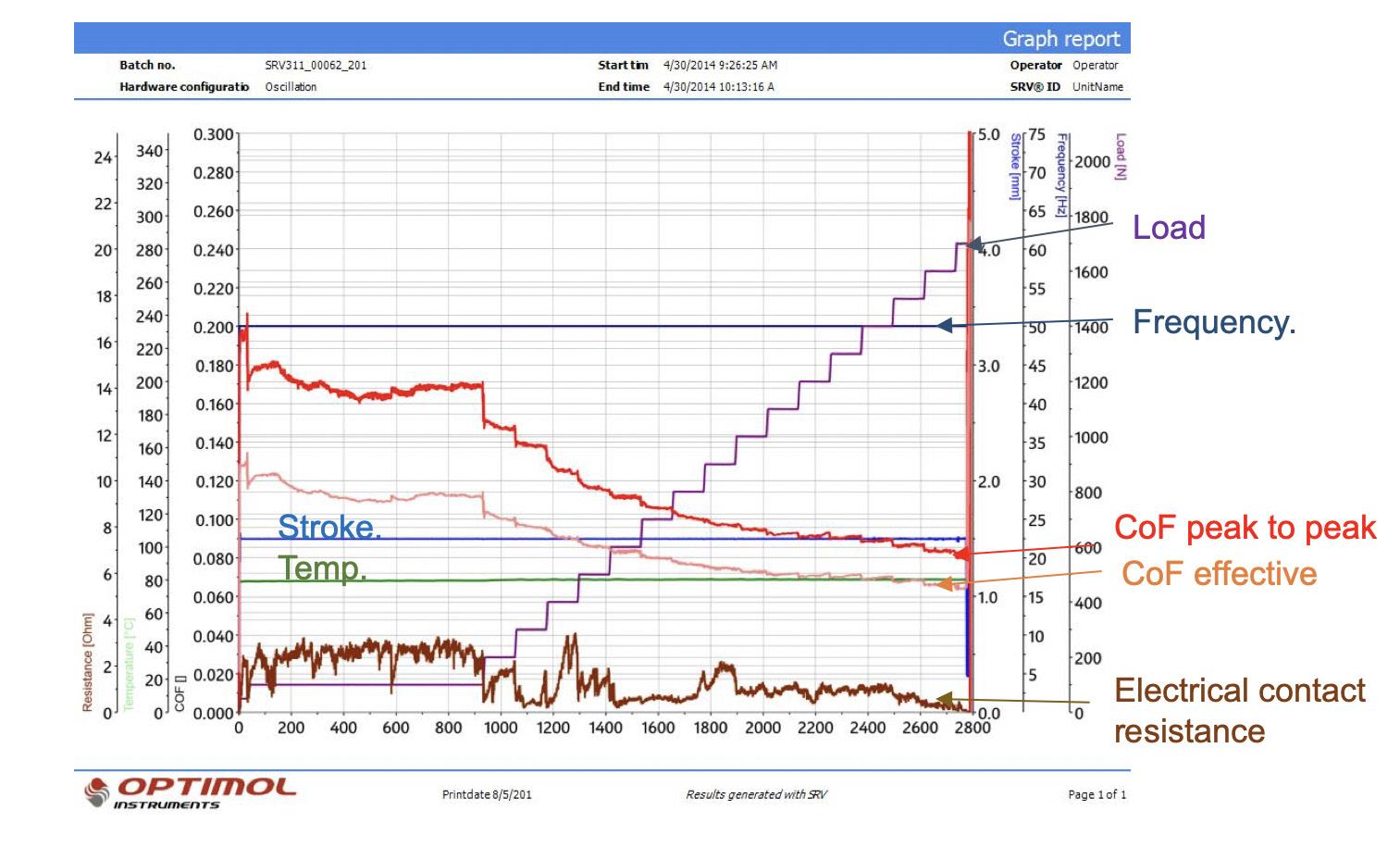
The electrical contact resistance sensor was used along with the friction sensor. The electrical contact resistance (brown line) between the two specimens was determined largely by the chemical composition of the lubricant and the resulting reaction layer (tribofilm) on the surfaces of the friction couple. As it can be seen in Figure 3, the electrical resistance approached zero shortly before adhesive failure occurred around 1,600 N (purple line) because the micro-asperities on the substrates “pierced” the reaction layer. The cutoff criterion for seizure is defined in the test method ASTM D5706, Procedure B as COF > +˙∆0.2 for over 20 s.
3.3 Tribomechanical properties of grease-lubricated plastic suspension joints - ASTM D7420
ASTM D7420 can be used to quickly determine the lubricating ability of greases for automotive plastic socket suspension joints. It has found wide application in qualifying greases for chassis systems. The method employs a material- and application-oriented approach based on inputs from field experience for characterizing the tribological behavior (friction and wear) using random, discrete, and constant parameter combinations. In this test, an injection-molded polymeric test disk (POM, polyoxymethylene copolymer) with three flat pins of diameter Ø= 3.0 mm, oscillates on a flat disk and represents the inner plastic socket joint surface. Figure 4 shows the adapter and specimens for this test.
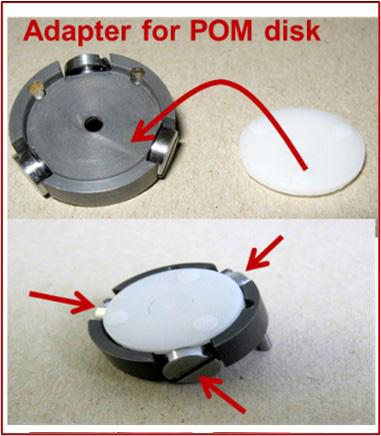
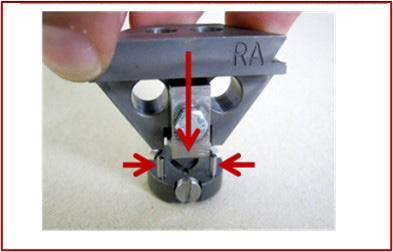
Figure 4: Test geometry and test conditions according to ASTM D7420
The test procedure was as follows: • Test load: 50 N / 2,000 N • Stroke: 1.5 mm • Frequency: 50 Hz • Temperature: 50 °C • Test duration: 120 min
The results of three repeat tests of a grease sample are illustrated in Figure 5. The specification TRW 62 051 301 requires a stable COF below 0.05. The low friction level and the high reproducibility of the results qualify this grease for practical applications. This grease was prepared from a blend of mineral and PAO (polyalphaolefin) base oils thickened with polyurea.
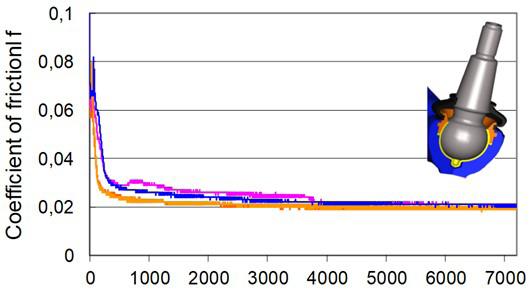
Figure 5. Evolution of COFs for one chassis joint grease (3 repetitions) according to ASTM D7420 – metal-polymer system
3.4 Determining the vibration wear resistance of greases at high Hertzian surface pressures - ASTM D7594
The increasing popularity of e-mobility and e-vehicles has recently received more attention and requests for determining the wear response of HP greases under fretting conditions. For this reason, the study of six different HP greases with different compositions according to ASTM D7594 is presented in this paper. The test parameters to simulate the real operating conditions of HP greases were:
• Stroke: 0.5 mm • Temperature: 150 °C • Frequency: 50 Hz • Time: 2 h • Load: 400 N
Remark: These test conditions differ from those stated in D7594: stroke of 0.3 mm, 100 N normal force, and high temperature of 50 °C. Table 1 displays the basic components of the six different NLGI grade 2 greases.

Table 1: Basic information about the six HP-greases tested in this study
For each grease, the ASTM D7594-type test was run twice. Figure 6 shows both values of the COF for each grease. The repeatability is good. For better comparison, the greases are divided into soap thickened greases, non-soap thickened greases, and one non-additized PFPE grease (Grease #6). Greases #2, #3, #4, and #5 showed the lowest comparable friction values, followed by Grease #1. Grease #6 (without any additives) showed higher friction values.
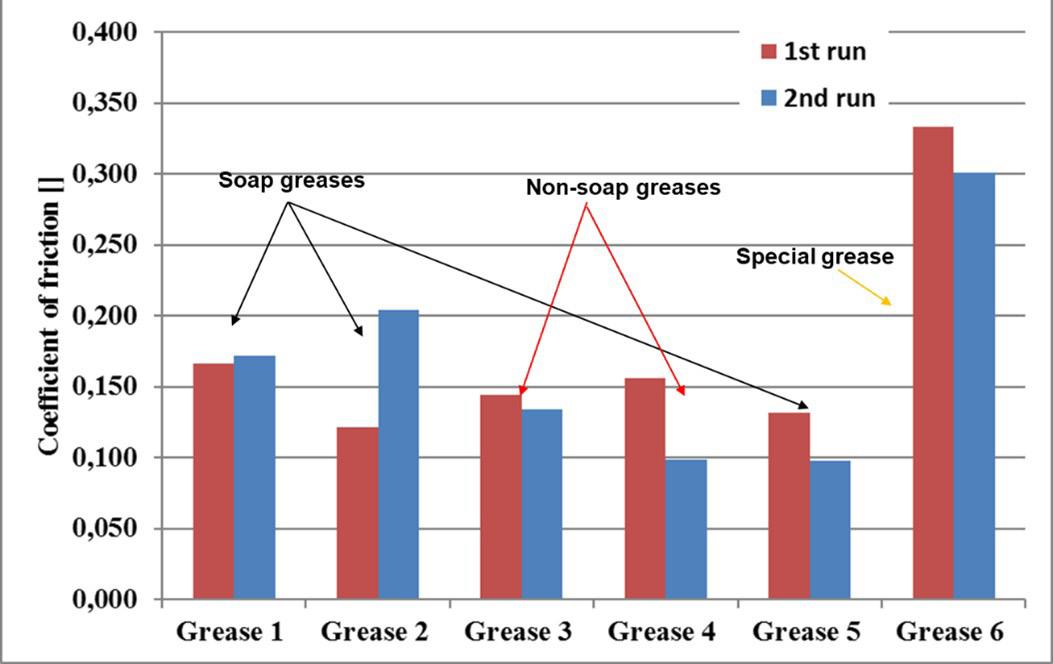
Figure 6: Comparison of fretting COFs for six HP Greases
Figure 7 shows the diameters of the wear scars on the disks and balls at the end of the tests; they were measured using a light microscope. According to DIN 51834-3 and ASTM D7755, the wear scar volumes can be measured with a stylus profilometer or a laser scanning microscope. Mean values of the wear scars for the ballg and the disk were considered separately. Grease #6 clearly had the largest wear scars in this test. Very small wear scars were observed for HP Grease #5 followed by HP Grease #3.
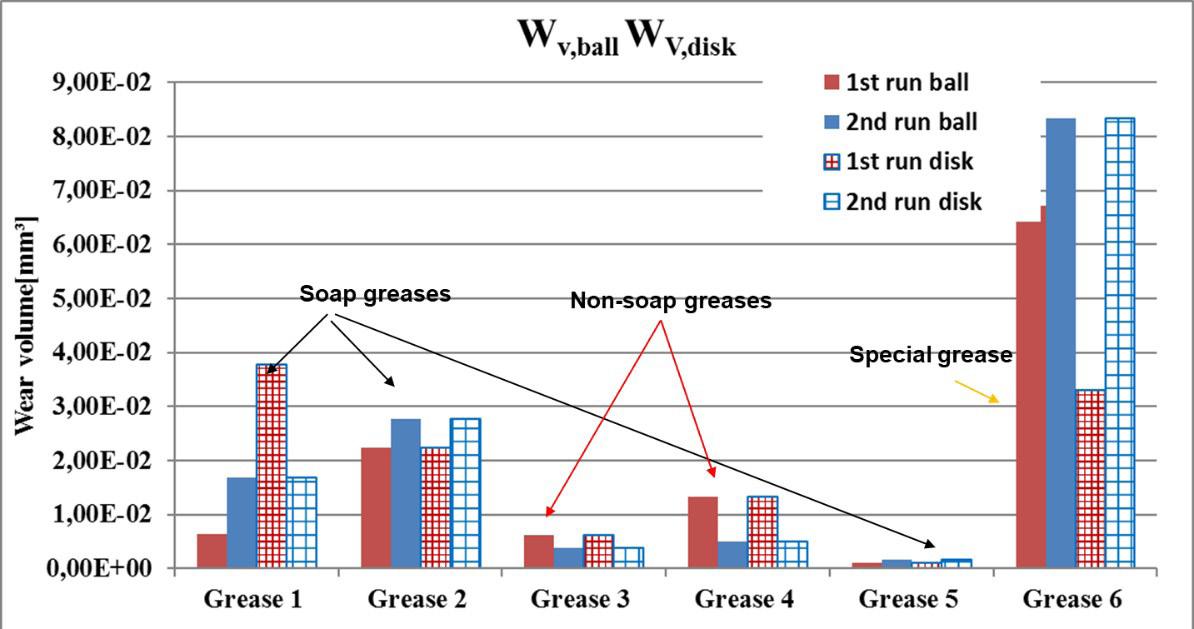
Figure 7: Comparison of fretting wear volumes for six HP greases
Figure 8 illustrates a comparison of two new HP greases. One grease formulation clearly passed this fretting test, and the other formulation failed. The progression of CoF values and strokes were observed on the monitor of the SRV®5 machine. After the test, pitting and fretting damage were observed. There were wear scars on the ball and wear tracks on the disk that were used to test the failed greases.
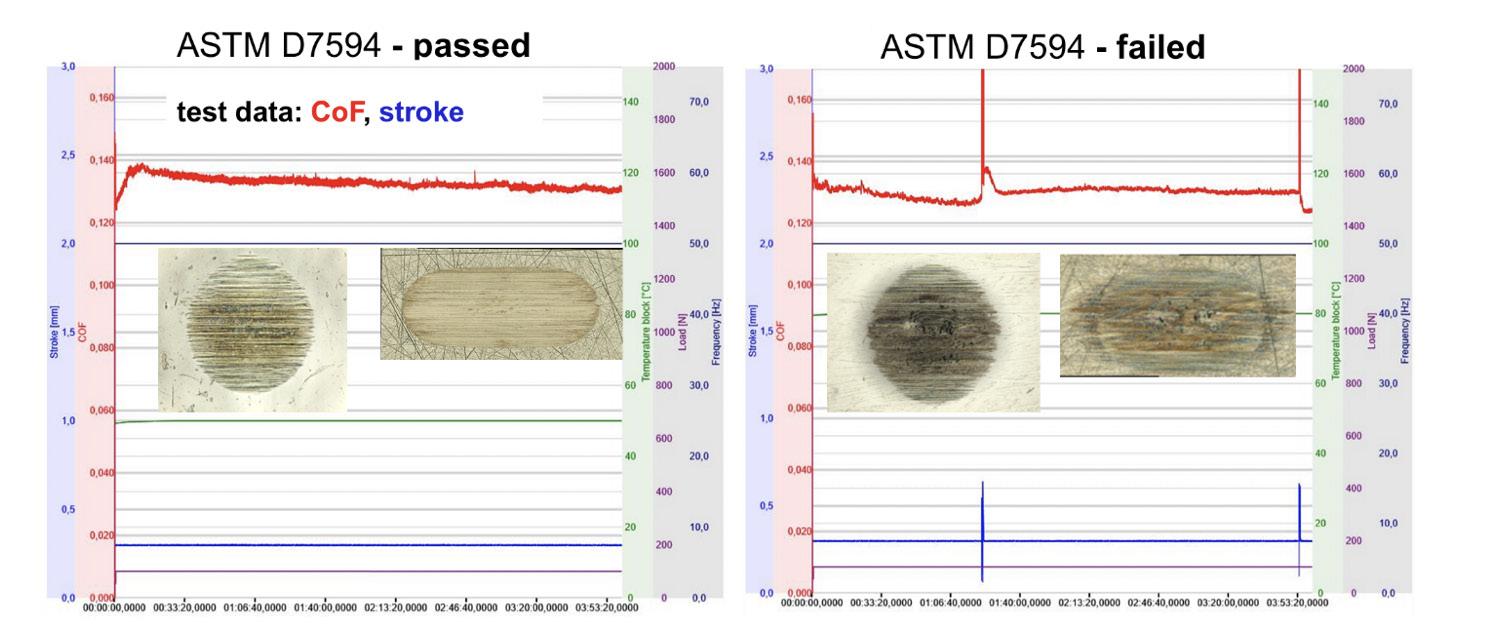
Figure 8: Comparison of fretting test results for two HP-Greases
Figure 9: Configuration of the rolling adapter and its position in the SRV® test chamber
This test method can distinguish between differently formulated HP greases in an easy manner and rather short time. Measuring COFs and wear volumes according to ASTM D7594 provides a functional profile of the performance of different grease formulations under fretting conditions.
3.5 Rolling friction and wear
The future of grease development is going towards energy efficient (low friction) greases. By optimizing the lubrication of rolling bearings, theoretical improvements of frictional losses can translate into longer ranges for e-vehicles. The existing SRV® test methods for greases are proven tests and used to compare tribological perfor¬man¬ces for greases under sliding conditions. The new test concept allows differentiation of the greases in connection with their tribological performances under high loads and low-to-medium speeds in pure rolling motion. The COF is determined under rolling conditions. In consequence, the values of the COF are below 0.01. The SRV® oscillation setup can be used to simulate other practical motion patterns as well. A new adapter was recently developed to simulate rolling movement and measure the rolling friction and the resulting wear of formulated greases.

Test parameters for this rolling test are as follows: • Temperature: variable (100 °C in ASTM WK71194) • Frequency: 20 Hz • Stroke: 1 mm • Load: 1 h at 500 N (running in), then increase to 2,000 N • Duration: 19 h or more
For normal force FN= 500 N, the Hertzian contact stresses for each roller are mean P0mean 710 MPa and maximum P0max 903 MPa. When FN= 2,000 N, the upper end of the range, then P0mean is 1,419 MPa and P0max is 1,807 MPa. More details about this procedure can be found in references 8 and 9. The test temperature should be chosen based on the quality, viscosity, and field application of the grease. For all greases tested until now, increasing the temperature generally caused higher wear values. The test duration of 19 h (in total) enabled tests to be run overnight. The criterion to stop a test was the predetermined test time or adhesive failure. The results for six different greases are presented in Table 2. Two greases were based on PAO with different thickeners (B1 and B2), and four greases were based on PFPE with different thickeners (S1, S2, S3, and S4).
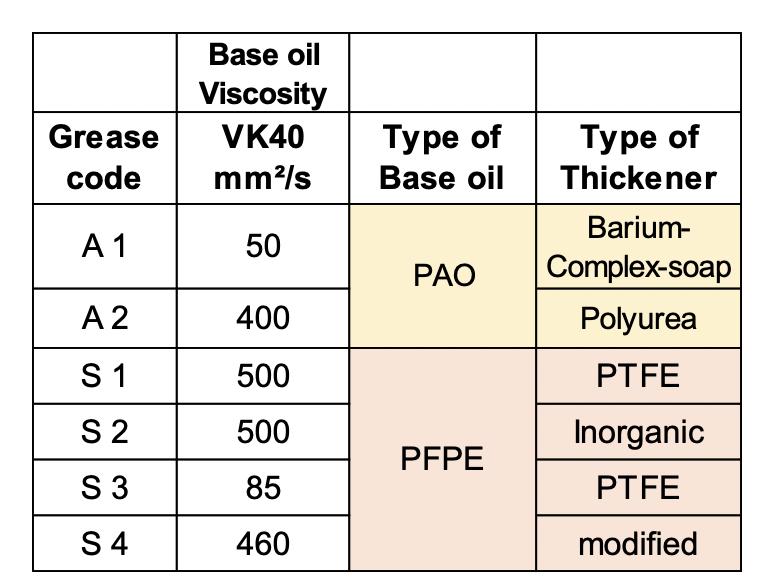
Table 2: Greases tested in rolling movement
The test results are shown in Figure and Figure . The effect of temperature on the planimetric wear values [µm²] is obvious. In the case of two greases based on PAO, Grease B2 gave better protection against wear than B1 at both temperatures.
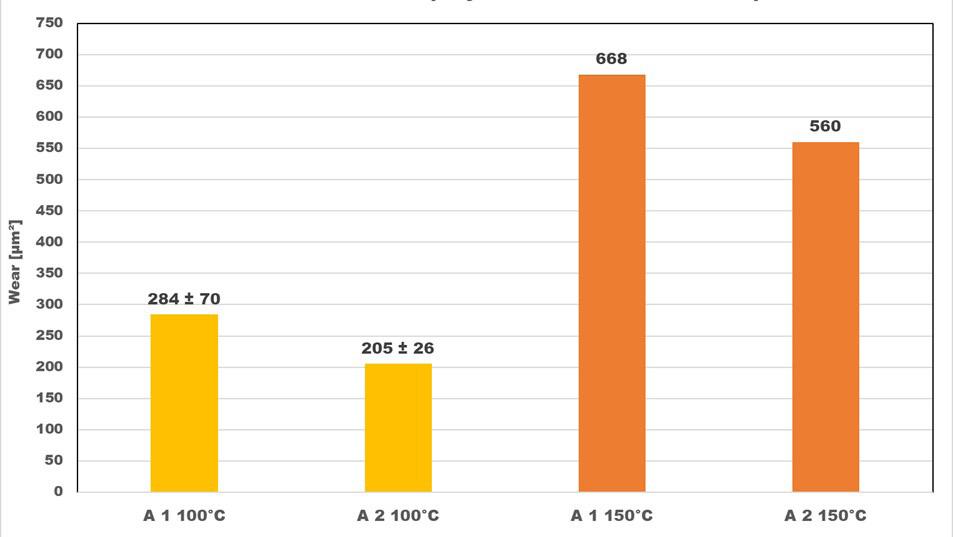
Figure 10: Rolling wear of two PAO-based greases at 100 or 150°C
Four HP-greases were based on PFPE oil for applications at high temperatures. Their performances differed in this test at 200 °C and 19 h test time.
Since 2018, two round robin tests were run successfully. The draft text of this test method passed two ballots as ASTM work item WK71194.
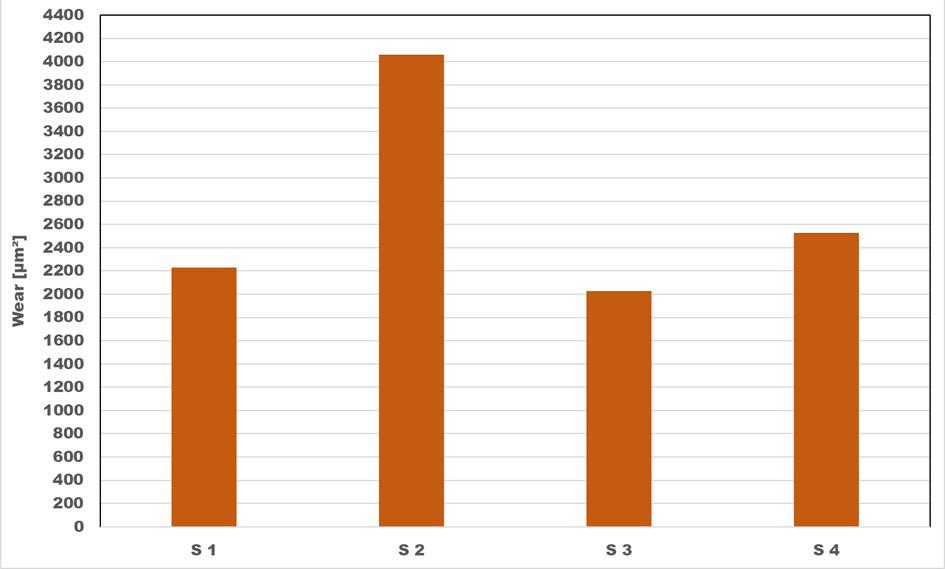
Figure 11: Rolling wear of four PFPE-based greases after testing at 200 °C
3.6 Grease testing under unidirectional sliding
Most axial wheel bearings are lubricated by greases; the application parameters are rather severe high loads and high velocities. The tribological test method using the SRV® rotation module has not been standardized for these conditions so far. The axial wheel bearing test setup can be modified in accordance with customer requirements. Figure illustrates the test configuration.
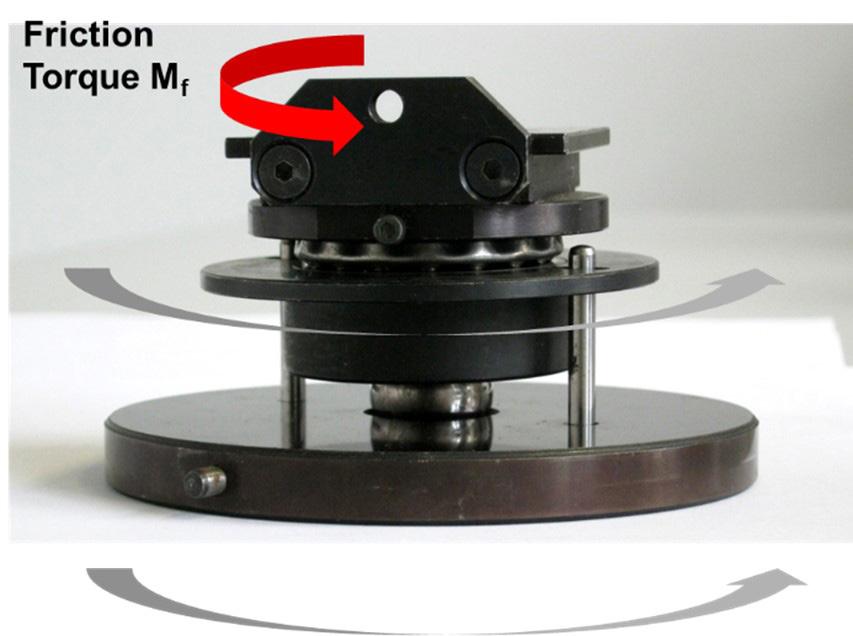
Figure 12: Friction moment measurement in an axial wheel bearing
• The upper track is firmly attached to the torque sensor. Hence, the rolling friction within the bearing is measured. • The lower track rotates, thus enforcing the rolling movement of the balls. • The rotational movement of the base plate is transferred to the lower track.
Two different greases (one fully-formulated grease and one grease without additives) were tested with this configuration of rotation modules using the following parameters:
• Temperature: RT • Test load: from 50 to 2,000 N • Rotational speed: 500 RPM Figure and Figure illustrate the test results showing the progression of the frictional torque and the temperature during the test time of 2 h. The tests were run with two different radius alignment shifts between both bearing raceways: a) Radius alignment of 0.00 mm b) Radius alignment of 0.02 mm
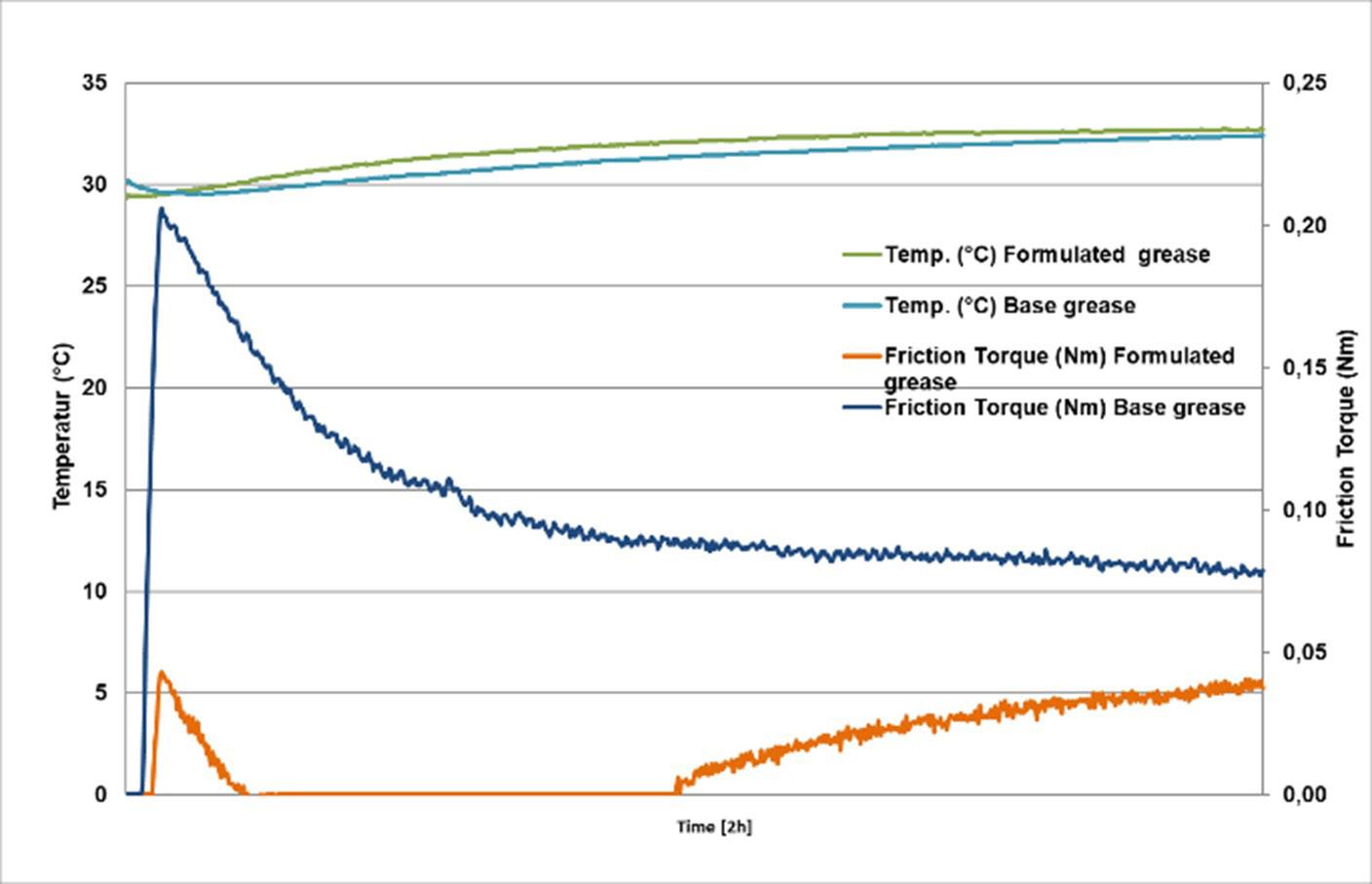
Figure 13: Results for two greases for axial wheel bearings tested with 0.00 mm radius alignment
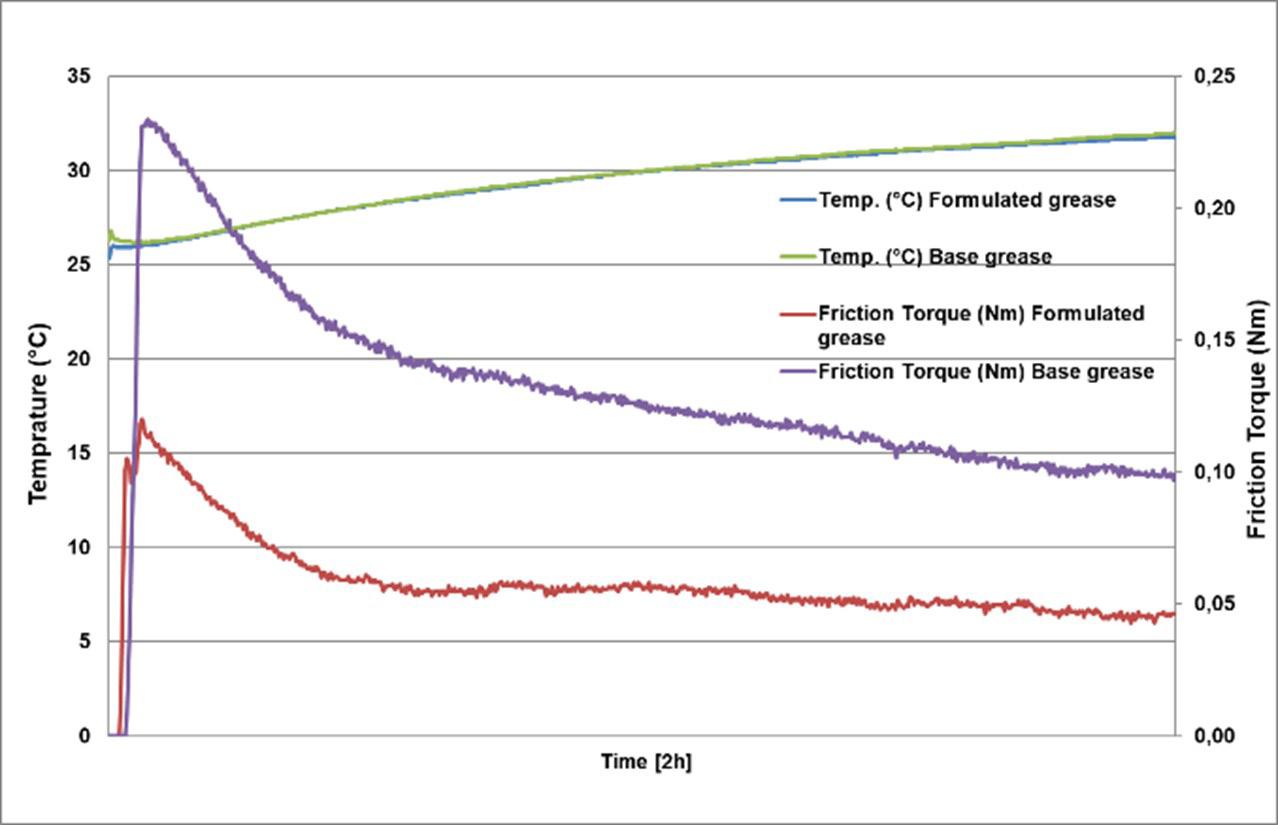
Figure 14: Results for two greases for axial wheel bearings tested with 0.02 mm radius alignment
These results clearly showed the differences in the tribological performances of these greases for applications in axial bearings. The frictional torque was significantly lower for the formulated grease than the base grease for both alignments. For both greases, the temperatures were higher and the torque values were larger with the 0.02 mm alignment than the 0.00 mm alignment. This configuration is a good simulation tool for testing greases for axial bearings and various application parameters.
4. Conclusions
• The different components of a greases form a complex lubricant. The functional profile of a grease must be determined as a function of operating conditions using different tribological test modes. • To develop a balanced formulation of a functional grease, different tribological tests are quite valuable and helpful. • Running a grease in different tribological tests at conditions very close to those in the field can generate a meaningful tribological profile of the grease. • Friction, wear, and extreme pressure properties were determined by means of standardized test methods using one instrument.
5. References
[1] E. Kuhn, Zur Tribologie der Schmierfette (On the tribology of lubricating greases), 2. edition, 2017, ISBN 978-3-8169-3339-7, Expert Verlag [2] J. Wang, et al, Grease film variation in reciprocating sliding motion, Tribology International, Vol. 114, 2017, p. 273-338
[3] Y. Kanazawa, et al, Film formation and friction in grease lubricated rolling-sliding non-conformal contacts, Tribology International, Volume 109, May 2017, p. 505-518. [4] R. Czarny, M. Paszkowski, The influence of graphite solid additives, MoS2 and PTFE on changes in shear stress values in lubricating greases, journal of synthetic lubrication, 2007; 24: p. 19-29 [5] G. Patzer, Evaluation of High-Performance Lubricating Greases on the Translatory Oscillation Tribometer, Materials Performance&Characterization Journal, ASTM International, Vol.7, No.3, 2018, p. 340-354 [6] M. Fathi-Najafi, J. Li and Y. Shi, Evaluation of the impact of high viscous naphthenic oils on various thickener systems, NLGI Spokesman, Vol. 84, no. 1, Nov./Dec. 2019, pages 32-43 [7] S. Weber and Ch. Busch, The importance of the test conditions for the development of highperformance lubricants to prevent vibrational wear by means of the SRV® test machine according to DIN 51834), Tribologie + Schmierungstechnik 62, 3/2015, p. 40-47 [8] A. Schneider et al., A novel screening method for tribological properties of high-performance greases, Proc.21st International Colloquium Tribology, 2018, p. 167-168, ISBN 978-3-9435-6333-7 [9] A. Schneider, Rolling greases test adapter offers new testing opportunities, Lubes`n`Greases EMEA, April 2018, p. 32-39
6. Glossary of Test Methods
ASTM International, 100 Barr Harbor Drive, PO Box C700, West Conshohocken, PA, 19428-2959 USA
ASTM D5706 Standard Test Method for Determining Extreme Pressure Properties of Lubricating Greases Using a High-Frequency, Linear-Oscillation (SRV) Test Machine ASTM D5707 Standard Test Method for Measuring Friction and Wear Properties of Lubricating Grease Using a High-Frequency, Linear-Oscillation (SRV) Test Machine ASTM 6425 Standard Test Method for Measuring Friction and Wear Properties of Extreme Pressure (EP) Lubricating Oils Using SRV Test Machine ASTM D7420 Standard Test Method for Determining Tribomechanical Properties of Grease Lubricated Plastic Socket Suspension Joints Using a High-Frequency, Linear-Oscillation (SRV) Test Machine ASTM D7594 Standard Test Method for Determining Fretting Wear Resistance of Lubricating Greases Under High Hertzian Contact Pressures Using a High-Frequency, Linear-Oscillation (SRV) Test Machine
ASTM D7755 Standard Practice for Determining the Wear Volume on Standard Test Pieces Used by High-Frequency, Linear-Oscillation (SRV) Test Machine ASTM D8316 Standard Test Method for Measuring Friction and Wear Properties of Extreme Pressure (EP) Lubricating Oils with the Roller-Disk Geometry Using SRV Test Machine ASTM WK71194 work item New Test Method for Measuring Friction and Wear Properties of Greases Under Rolling Motion Using SRV Test Machine DIN Deutsches Institut für Normung e. V., Saatwinkler Damm 42/43 13627 Berlin, Germany
DIN 51834-2 - Testing of lubricants - Tribological test in the translatory oscillation apparatus - Part 2: Determination of friction and wear data for lubricating oils
DIN 51834-3 Testing of lubricants - Tribological test in the translatory oscillation apparatus - Part 3: Determination of tribological behaviour of materials in cooperation with lubricants DIN 51834-4 Testing of lubricants - Tribological test in the translatory oscillation apparatus - Part 4: Determination of friction and wear data for lubricating oils with the cylindrical roller-disk geometry ISO International Organization for Standardizatio,, Chemin de Blandonnet 8, CP 401 - 1214 Vernier, Geneva, Switzerland
ISO/IEC 17025 General requirements for the competence of testing and calibration laboratories ISO 19291 Lubricants — Determination of tribological quantities for oils and greases — Tribological test in the translatory oscillation apparatus
TRW Inc. (TRW Automotive was acquired by ZF Friedrichshafen AG in 2015)
TRW 62 051 301 an internal standard for chassis lubrication







